Dewatering Screw Press
Efficient, Continuous Sludge Dewatering Solution
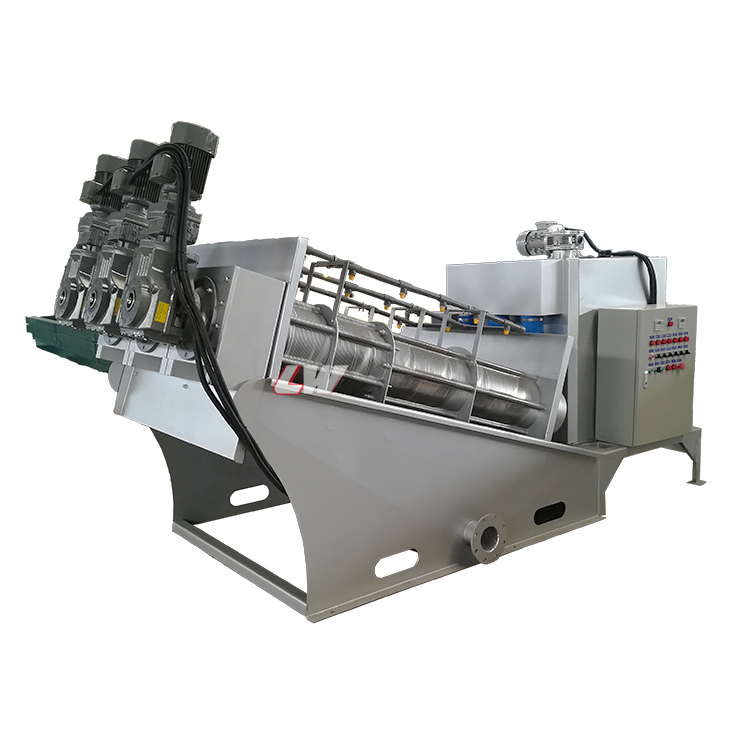
The screw press sludge dewatering machine represents cutting-edge technology in wastewater treatment and sludge management. The screw press dewatering system creates powerful compression force through variations in screw diameter and pitch, combined with the tiny gaps between moving rings and fixed rings, making it an exceptional sludge treatment equipment for modern wastewater facilities.
As a leading solution for sludge dewatering, the screw press sludge dewatering machine offers superior performance.
Loway state-of-the-art sludge dewatering equipment features a robust construction with stainless steel components (ss304/314s), ensuring long-term durability and minimal maintenance requirements.
The unique design of this screw press dewatering technology enables continuous operation with minimal supervision, making it the preferred sludge treatment equipment for facilities seeking operational efficiency and cost reduction.
Key Advantages
✅High Dewatering Efficiency: Achieves superior dry solid content in final sludge cake
✅Continuous Operation: Designed for 24/7 automated processing
✅Low Energy Consumption: Energy-efficient design reduces operational costs
✅Minimal Maintenance: Self-cleaning mechanism prevents clogging
✅Fully Enclosed System: Eliminates odors and provides clean operation environment
✅Compact Footprint: Space-saving design for installation flexibility
✅Automatic Control System: PLC-based operation with remote monitoring capabilities
Working Principle and Process
Core Operating Mechanism
The dewatering process begins when conditioned sludge enters the screw press dewatering chamber through the inlet feed system. The sludge undergoes progressive dewatering as it moves through several distinct zones within the equipment.
Feed Hopper
Sludge or wet material is first introduced via the feed hopper. A reliable feed pump or conveyor ensures stable flow.Conditioning Zone
In many applications, pre-conditioning with flocculants (e.g., polymers) improves dewatering efficiency. This occurs in a mixing chamber before extrusion.Screw Extrusion Section
A tapered screw shaft increases pressure gradually. As the pitch narrows, moisture is squeezed out through the perforated press cage.Filtrate Collection
Expelled liquid (filtrate) passes through the cage openings into collection channels, then diverted to clarifiers or recycle lines.Cake Discharge
The dewatered “cake” material exits the narrower end of the screw. Conveyors or chutes transport it for disposal, composting, or further processing.Control & Automation
PLC-based control panels regulate screw speed, feed rate, and polymer dosing, ensuring consistent solids content in the cake.

Working Principle
At the heart of the sludge dewatering screw press lies the screw extrusion principle:
Variable Pitch and Diameter: The screw shaft’s pitch and diameter taper from feed to discharge, creating zones of gradually increasing pressure.
Fixed vs. Floating Rings: A small gap between the rotating screw and stationary rings enables controlled drainage. Floating rings adapt to material build-up, maintaining consistent pressure.
Perforated Press Cage: High-strength stainless steel or alloy steel cages feature precision-drilled holes, optimized in diameter and spacing for targeted solids retention.
Extrusion Force: As material moves forward, the narrowing channel compresses the sludge, forcing water through the cages while compacting solids into a dense cake.
Performance Parameters
- Capture Rate: >95% solid capture efficiency
- Cake Consistency: Stackable, non-sticky cake
- Water Content Reduction: 75-85% moisture removal
- Polymer Efficiency: Optimized dosing for minimal consumption
- Continuous Operation: 24/7 operational capability
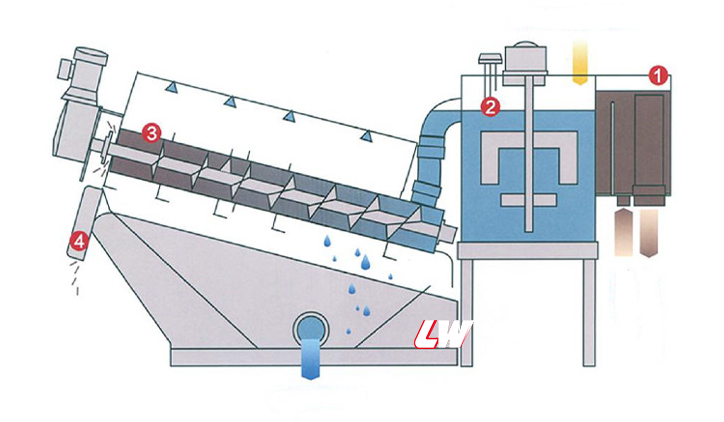
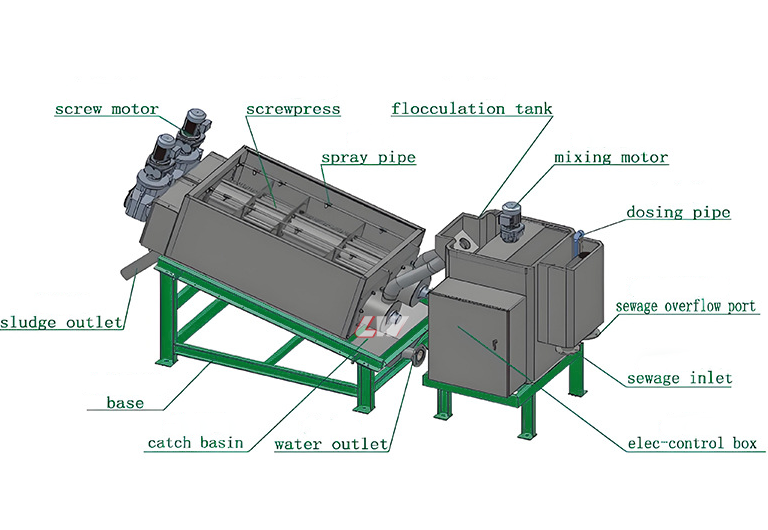
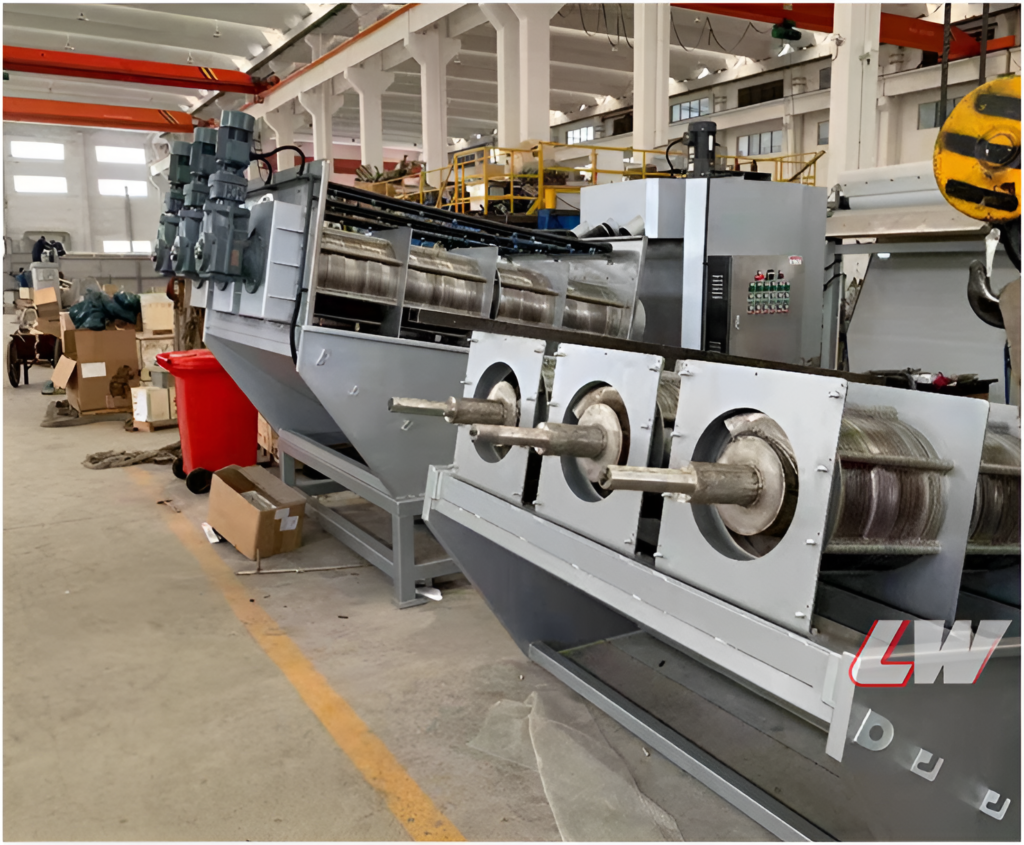
Key Components
Screw Conveyor Assembly: The heart of the dewatering screw press features precision-engineered spiral flights with variable pitch design. Manufactured from high-grade stainless steel, the conveyor ensures consistent performance and corrosion resistance.
Filtration Screen System: Advanced wedge-wire screen technology provides optimal filtration efficiency with self-cleaning capabilities. The screen design minimizes blinding and maintains consistent flow rates.
Drive System: Heavy-duty gearbox and motor assembly delivers reliable power transmission with variable speed control capabilities. The drive system is designed for continuous operation with minimal maintenance requirements.
Pressure Control Mechanism: Adjustable back-pressure system allows optimization of dewatering performance for different sludge types. This feature ensures maximum cake dryness while preventing equipment overload.
Polymer Feed System: Integrated chemical dosing system provides precise polymer addition for optimal sludge conditioning. The system includes flow control and monitoring capabilities.
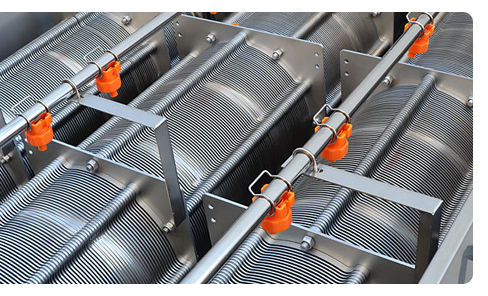
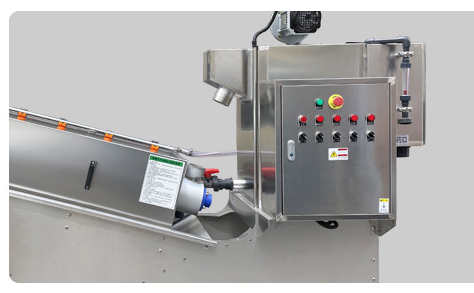
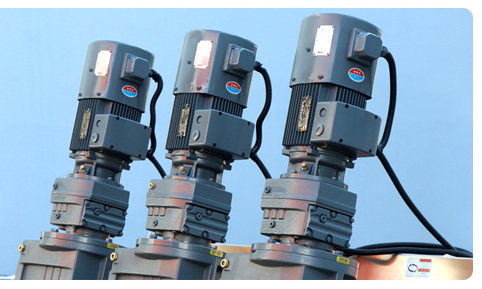
Process Overview
Feed Hopper
Sludge or wet material is first introduced via the feed hopper. A reliable feed pump or conveyor ensures stable flow.Conditioning Zone
In many applications, pre-conditioning with flocculants (e.g., polymers) improves dewatering efficiency. This occurs in a mixing chamber before extrusion.Screw Extrusion Section
A tapered screw shaft increases pressure gradually. As the pitch narrows, moisture is squeezed out through the perforated press cage.Filtrate Collection
Expelled liquid (filtrate) passes through the cage openings into collection channels, then diverted to clarifiers or recycle lines.Cake Discharge
The dewatered “cake” material exits the narrower end of the screw. Conveyors or chutes transport it for disposal, composting, or further processing.Control & Automation
PLC-based control panels regulate screw speed, feed rate, and polymer dosing, ensuring consistent solids content in the cake.
Technical Specifications of Loway Dewatering Screw Press
Model | DS Standard Treatment Capacity | Sludge Treatment Capacity | |||||
5000mg/L | 10000mg/L | 20000mg/L | 30000mg/L | 40000mg/L | 50000mg/L | ||
LWSP-101 | 4 – 8kg/h | 0.8t/h | 0.5t/h | 0.3t/h | 0.25t/h | 0.2t/h | 0.1t/h |
LWSP-131 | 6 – 15kg/h | 1.6t/h | 1.2t/h | 0.7t/h | 0.5t/h | 0.3t/h | 0.2t/h |
LWSP-132 | 15 – 25kg/h | 3.0t/h | 2.0t/h | 1.4t/h | 1.0t/h | 0.7t/h | 0.5t/h |
LWSP-201 | 15 – 20kg/h | 3.0t/h | 1.8t/h | 1.5t/h | 1.0t/h | 0.6t/h | 0.3t/h |
LWSP-202 | 30 – 45kg/h | 5.0t/h | 3.0t/h | 2.8t/h | 1.9t/h | 1.2t/h | 0.6t/h |
LWSP-203 | 30 – 60kg/h | 9.0t/h | 6.2t/h | 4.0t/h | 2.8t/h | 1.6t/h | 0.8t/h |
LWSP-301 | 50 – 70kg/h | 9.0t/h | 6.0t/h | 3.0t/h | 2.5t/h | 1.8t/h | 0.9t/h |
LWSP-302 | 100 – 140kg/h | 16.0t/h | 12.0t/h | 6.0t/h | 4.8t/h | 3.5t/h | 2.4t/h |
LWSP-303 | 150 – 210kg/h | 25.0t/h | 18.0t/h | 9.0t/h | 7.0t/h | 4.5t/h | 3.5t/h |
LWSP-304 | 200 – 280kg/h | 35.0t/h | 24.0t/h | 12.0t/h | 9.5t/h | 6.0t/h | 4.8t/h |
LWSP-401 | 140 – 200kg/h | 30.0t/h | 18.0t/h | 10.0t/h | 6.0t/h | 3.5t/h | 3.0t/h |
LWSP-402 | 250 – 350kg/h | 60.0t/h | 30.0t/h | 15.0t/h | 10.5t/h | 7.0t/h | 6.0t/h |
LWSP-403 | 320 – 500kg/h | 90.0t/h | 45.0t/h | 23.0t/h | 16.0t/h | 11.5t/h | 9.0t/h |
LWSP-404 | 500 – 700kg/h | 120.0t/h | 60.0t/h | 32.0t/h | 20.0t/h | 16.0t/h | 12.0t/h |


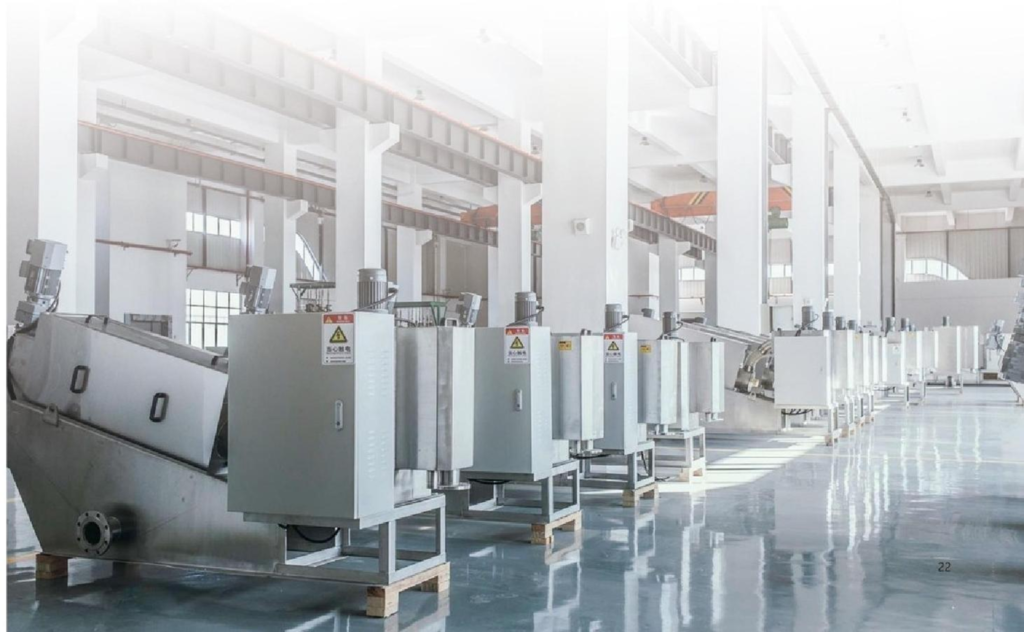
Common Questions
Have More Questions? Our technical team is ready to provide detailed, personalized guidance.
Q1: What types of sludge can the dewatering screw press handle?
Our screw press dewatering equipment effectively processes various sludge types including municipal sewage sludge, industrial waste sludge, food processing waste, and organic materials. The system adapts to different sludge characteristics through adjustable parameters and polymer conditioning.
Q2: Can I handle chemical sludges with this machine?
Yes. The press cage and screw can be fabricated from corrosion-resistant SS316L or lined with specialized coatings to withstand aggressive chemicals.
Q3: What pre-treatment is required?
Most applications benefit from flocculant or polymer dosing to agglomerate fine particles. Some high-solids feeds may be processed without additives.
Q4: Can the system operate automatically?
Yes, our dewatering screw press features advanced automation capabilities including PLC control systems, remote monitoring, and automatic adjustment of operating parameters. The system can operate continuously with minimal operator intervention.
Q5: Is the machine suitable for cold climates?
Yes. Optional jacketed housings and heated feed lines prevent freezing, ensuring reliable operation in sub-zero conditions.
Q6: Can the system handle varying feed conditions?
Yes, the screw press dewatering system is designed to handle fluctuating feed conditions including variations in sludge concentration, flow rate, and characteristics. The adjustable back-pressure mechanism and variable speed drives ensure consistent performance across diverse operating conditions.
Q7: How do I maintain the Screw Press?
Regular checks include greasing bearings, inspecting rings and cage perforations, and cleaning the feed hopper. Wear parts such as rings and flights can be swapped out with minimal downtime.
How it works
We provide one-stop service of solid-liquid seporator planning, design, consultation, construction, equipment manufacturing, installation, commissioning and training. We are involved in complete sets of sludge dewatering projects for various industries.

Consultation what you need.
We do not aim to achieve maximum profit and do not reduce the quality of our products by catering to the market with low prices. We are happy to provide high quality tailor-made filtration equipment to you.
Production the filter press equipment for you
Our professional and advanced production technology, excellent manufacturing process, and perfect testing ensure that your equipment fully meets the quality acceptance standards.
Installation and commissioning equipment
Our skilled installation team installs this equipment for you in strict accordance with the construction drawings and construction process steps. Experienced technicians will debug and analyze the average results on site to achieve the best results and meet the needs of use.
After sales service
Our technicians patiently and meticulously answer all your questions and provide guidance and suggestions through messages, phone calls, videos, and arriving at the site.
